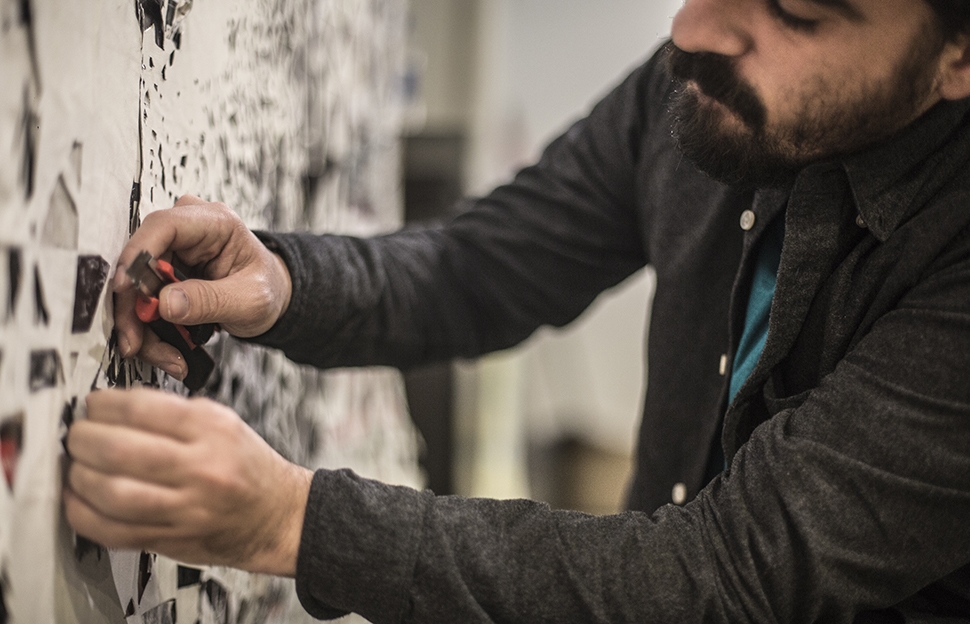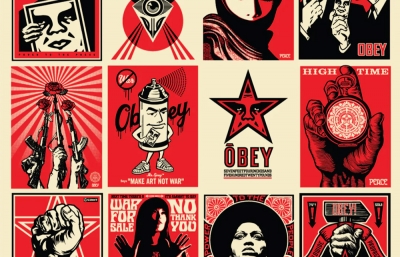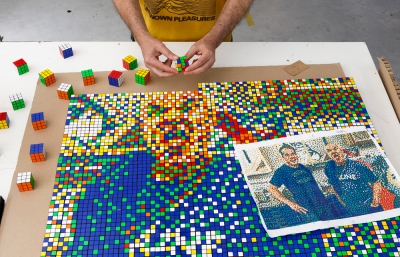VHILS
Etching the Stories of a City
Interview and text by Roger Gastman and Portrait by José Pando Lucas
VHILS first soared into my radar around 2008. By that point, graffiti was already a massive worldwide culture that people from different fields were not only trying to understand, but also monetize. Of course, since there was money to be made—and the medium itself is built upon an illegal foundation—those same people searched for a marketplace moniker to help explain why a kid who painted his name in big bold letters on the side of a train was suddenly showing at prestigious galleries around the world and bestowing coolness on household brands.
The term “street artist” was there for the taking. Not a new term, having been used widely in the “internal community” since the ’80s, it really seemed to catch on, post Y2K, as more and more artists adopted and ran with the principles of graffiti.
I myself grew up as a graffiti writer, but I never thought about the term until the late ’90s. Everything was just sort of graffiti or some sort of vandalism to me. However, art dealers, collectors and marketing directors around the new millennium began to see the potential in exploring such works and their inherent narratives. Just like the more traditional graffiti vandal, these street artists were out there, often under the cover of night, doing their thing.

Supposedly, a person who writes graffiti is driven by an adolescent desire to see their name widely, big and bold as possible. But the “street artist” takes the principles of graffiti, utilizes the street as a canvas, and packages it in a way that many felt was more important than the movement that spawned it. This wasn’t the view of core members, but once the press latched on, the “street artist” label was hard to shake.
In the mid-’90s, there were graffiti jams all over Europe. Similar events largely dedicated to graffiti artists and hip-hop took place in the US, and with the rise of street art terminology in the mid 2000s, these events morphed into street art festivals. In the last five years, when dedicated mural festivals start to add to the already confusing classification system, artists from all over the world were lumped together. Hardcore graffiti writers, street artists, and some just there to paint something really fucking big, resulted in a stew of experiences and styles that further muddled the concept.
Regardless, it definitely was, and still is, a good thing that so much public art was happening. And all those cooks in the kitchen brought out the competitive spirit. The same drive that kids had making illegal works on the street was now brought to the walls, resulting in, “How do you stand out, and how can you make people notice when there’s so much art on the streets?”

Enter VHILS.
Make no mistake, VHILS started as a graffiti writer. But as a street artist, he was able to put Lisbon and Portugal on the map. I’ve come to understand, over the 25+ years of involvement with graffiti, that artists always want to push the boundaries of what’s possible. It’s my belief that VHILS didn’t wake up one day declaring his wish to be a street artist, but was really more about, “How can I keep pushing myself to be better?”
I think VHILS channeled his frustrations, most assuredly the result of walls being buffed, writers going over his work, and the social climate of the world, into what has become an unmistakable visual language that involves chiseling into a structure. Whereas spray paint has a finite shelf life on the streets, VHILS’s etchings imbue the building or structure. I liken it to a scar on the human body; it can’t be erased, and it comes with a good story.
People forgot VHILS ever did graffiti because his new work feels so personal and connected to his interests, like social causes, movements, and the people who shaped him in different international cities. That’s not something he could portray with graffiti—no matter how intricate the letter connections, how detailed the characters were, or what text accompanied his name. The artistic drive, plus a vandal’s mentality, produced something really unique.

For me, VHILS became a graffiti artist who uses new mediums. Although he will probably always be labeled a street artist, VHILS is a student of graffiti who grabbed what he was doing and pushed it further. It evokes the spirits of REVS, COST, and FREEDOM in New York City decades earlier, when they drove themselves and changed the city. In my opinion, the best street artists are the ones who had just one goal—to get up and do MORE.
Particularly, I like how VHILS has continued his expression in the gallery setting. I’ve seen people attempt to scale their pieces to fit within the parameters of a museum or gallery space, only to lose the magic in the process. But VHILS finds a way of making his work feel as though it’s been there a decade before the show took place, and will probably be there a decade later, when the building gets demolished. Timeless.
In late February at the Contemporary Art Center (CAC) in Cincinnati, Ohio, VHILS will mount Haze one of his most ambitious exhibitions to date. The culmination of work he’s developed up until now focuses on contemporary urban development and the effects of globalization on our individual cultural identities, a monumental message addressing how we collectively sit at the forefront of a new decade, challenged with a world we’ve created at dubious cost.

Project for the new headquarters of GS1 Portugal, Center for Innovation and Competitiveness, Lisbon, 2016
Roger Gastman: With so much reflection in your work, what do you intend the viewers to gain by looking back?
Vhils: To me, the importance of the reflection I've been working on over the years lies mainly in knowing where we came from, in order to avoid past mistakes. This is an oversimplification, of course, and the idea is not really to force people to look back, but rather find the time to slow down and pay attention to what is going on around them today, to pay attention to the moment, to who we have become and how, to try to look beyond the glitzy facade of the global model of socio-economic development we follow, focusing on the deep shadows it casts on human beings around the world.
What I'm trying to highlight is how fragile what we have achieved, created or accomplished really is—whether it is a system, a city, a country, a culture—how a simple spark can blow up everything we take for granted in times of peace and prosperity. Underlying all of this is the unbridled process of globalization. It has brought many benefits, such as increasing cultural and individual interaction, fostering trade, creativity and innovation, as well as raising living standards and giving unprecedented material comfort. But globalization also poses great challenges and comes at great cost by giving rise to an increasingly homogenized transnational identity responsible for eroding the elements that once made each culture unique, placing a huge strain on the sustainable management of our planet's limited resources through an emphasis on overproduction and overconsumption. We have created a culture of obsolescence and fast-replacement as our vast social and national asymmetries generate new conflicts, forcing population shifts. We have gained much in terms of material comfort, but we’ve given up so much in its place, and where does it lead? Becoming increasingly disconnected from the nature we came from and more dependent on technology, are we as free as we think?
In being increasingly connected, we ignore the fact that, in truth, we are becoming more and more disassociated from who we are and the natural world. These are some of the topics I have been exploring with my work. What I try to do is to create still lifes by capturing fragments of the present, and glimpses of moments of our contemporary cities contained in the materials they discard.

Aldeia de Araçaí, Piraquara, Paraná, Brazil, 2014
I’m sure you’ve heard this one before, but who and what is the significance of the people in your portraits?
The use of portraits is a way of reflecting on the present human condition within the context of a global society that lives mostly in urban environments. It's a way of addressing issues such as how much of who we are is personally ours, and how much of it is owed to the places where we live, the adverts we see, the things we consume, the architecture and brick walls that surround us every day. Where do our aspirations come from and what are we really built of? In this day and age of vacuous celebrities, I make an intentional choice to highlight the value of ordinary people who I view as the unsung heroes of everyday life.
Inspiration for my portraits comes from my travels and work experiences in different cities, from photographs I take myself, or find while researching historical archives related to a particular location, and even from glimpses of images that somehow become ingrained in my memory. Sometimes I’ll use composites, creating a new image that can represent people in general, while not depicting anyone in particular. It all depends on the nature and scope of the project. Some of the real people have a specific connection to the location. In some of the larger projects, especially those involving a community, this involves getting to know them, sharing experiences, listening to their stories and concerns, photographing them in their environment, and then carving their portraits where they have a particular connection.
In other cases, when I arrive in a city, I might walk around the streets, and simply ask people if I can take their photo. I explain what I want to do with the image and ask them a few questions. Even if it's a short conversation, I always like to have a sense of who this person is, where they come from, what they do, what they like, but also if their city and culture has changed much over the years and how—things like that.
A portrait speaks of identity and human nature, and my pieces, in particular, seek to explore poetically the intimate relationship between the city and the people who live there, how both are locked in a cycle of reciprocal shaping, each contributing to the other's character. The city is fundamentally the people who helped shape it, but while doing so, the people are also being shaped. By carving a portrait on a wall, I try to reveal some of the city’s older layers, making them part of the piece. While expressing something of the history and the life of a given place, these contrasting textures also speak of our own layers, our own wrinkles, our own personal history.

Portrait of Cesária Évora (1941-2011), São Vicente island, Cape Verde, 2019
Having exhibited worldwide, are there key differences in how different audiences interact and communicate with your work?
It varies from individual to individual more than culture to culture. Which, in itself, speaks volumes on how, by being subjected to the same elements due to the process of globalization, we are growing increasingly alike around the world.
I once looked at a material list for a large-scale piece you were doing and was astounded by the physical demands. From the many drills and hand chisels, the physical nature of creating your work requires grit, as well as finesse. This is a process you can find in artists’ studios but not usually with such scale. How do you maintain such momentum in the work you produce, and what are the challenges working this way outdoors?
When I first started, it was complicated, as I did everything on my own. But as my work progressed, I reached a stage when I realized that I had to set up a team to help if I wanted to keep on creating bigger and more sophisticated pieces, especially when working outdoors. I'm lucky to have brought together a talented and multi-skilled group of people who help me with issues regarding logistics and production. This enables me to focus on the creative side of things and the prep work before a piece is executed.
It’s still complicated to organize and develop, but a great help to know that we can tackle any project anywhere around the world by following a series of procedures. We don't just walk up and start improvising. When traveling, we take some of the tools, but source the rest on location, and most of the work I do in the streets nowadays is sanctioned, so we have all the permits and all. When we arrive at a wall, everything has been prepared beforehand. There are always last-minute details, but it's mostly just shifting into gear and carrying out a project that is well defined. We're still pretty young and somewhat fit, so that helps with the demand of working with heavy tools. In a sense, we have more in common with a construction crew than an art studio!
The same goes for my studio work, where everything is so organized that most of the challenges have been dealt with already. But I also do a lot of experimentation, research and development, which, to me, is the most exciting part, and that is always riddled with challenges and mistakes. This is all part of the process and always seen as positives, as they point to creative solutions and new lines of work to explore.
Process is also part of the message contained in my work. The choice of materials, tools and process is not random; they are all very significant. I'm in constant dialogue with destruction as an act of creation—which, when you think about it, is not very different from any other artist who will destroy a white canvas by covering it with layers of paint. I love this idea of having dialogue with the materials, with the inherent chaos of their inherent history. The layers that build up chaotically in these materials—walls, wooden doors, and amalgamations of billboard ads—are the color palette that fill the image I want to extract from the structure. I never know what I'm going to find, and that's what I love. I'm not exactly making what I want to create, but creating a dialogue with the chaos that’s already there. All of this is very similar to how human beings shape their identity, so, to me, there is a clear connection between these two things.

Explosion work, 2019
How do you feel about being termed a street artist with such a heavy background in graffiti?
Well, coming from graffiti, I have never been comfortable with the terms street artist or street art, especially when applied to my work. Then again, these are simply labels, a way of organizing things neatly in a box. I understand they can be useful to many people, but I just don't really identify, and I think they are somewhat limiting. I create work in many contexts, both indoors and out, and all of it is art, pure and simple. It owes a lot to graffiti and it owes a lot to the way it developed in the streets, but it's no longer the former and it's not limited to the latter. It's just art.
From the countless billboard ads to the doors, how do you source all the global material that goes into your work?
For exhibitions, I always try to source most of the materials from sites in the city it is being presented, commonly blended with materials sourced from other locations to tie in as a reflection on the present global reality I've been developing. So I might create a piece with an overlay of billboard ads from Hong Kong, Lisbon or New York with a portrait of someone from Brazil, for example. It's interesting to see how such things are so alike in these different corners of the world due to our homogenized consumption habits. The only thing that changes is the language.
The layers of billboard ads are removed from the streets, the doors and other wooden components are taken from derelict buildings or sites, sometimes obtained from companies specialized in salvaging old construction fixtures and materials. For these, I try to work with materials the city discards, which also speaks of the waste generated during a city’s cycle of destruction and creation.

What has been your biggest challenge with this upcoming exhibition? And what are you most excited about?
The biggest challenge has been the scale of the whole show and working to adapt the installations to the building's characteristics. I'm very excited to be presenting a project which I have never done indoors before, but I can't reveal it for the time being. I'm also excited about the opportunity to show my work in such a prestigious institution which has worked with many artists I've so admired since first starting out.
VHILS’s exhibition, Haze, is on view at the Contemporary Arts Center, Cincinnati through July 6, 2020.
Portrait by José Pando Lucas






